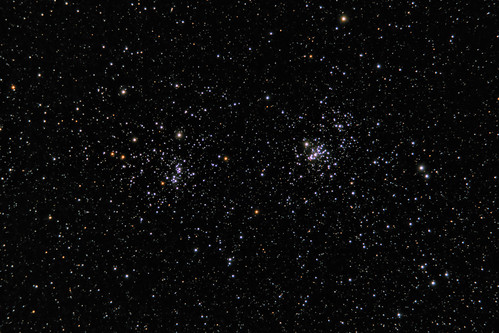2 November 2018, 19:45 – 21:45 GMT
Cold, very light wind, transparency improving over the course of the session.
Double Cluster, Perseus
Viewed at 50x (24mm Panoptic). Comparing against recent photo (above). The lower magnification is better for framing the clusters – at the expense of some contrast – but the eyepiece view always beats the photographic representation. Red giant stars showing well.
Cr 466, open cluster in Cassiopeia
Large and loose, would probably look better in a wide field refractor.
vdB 1, reflection nebula in Cassiopeia
First entry in O’Meara’s Secret Deep book. Despite its obscure designation it stood out reasonably well as an extended, if subtle, haze surrounding three stars. Not surprisingly the Ultrablock did nothing to improve the view (other than damping the glare from Beta Cas). Probably worth revisiting at higher magnification on a darker night.
M76, Planetary Nebula in Perseus
Prolonged averted vision (+ Ultrablock filter) seemed to reveal the faint “loop” extensions on either side of the main nebula (brighter on one side). Starting to wonder whether an O III filter might make a significant difference on this and similar nebulae.
NGC 1501, Planetary Nebula in Camelopardalis
133x + Ultrablock filter: green-grey disc which seemed to subtly change shape depending on which side of it I was looking. Otherwise, same details seen as on 9 October.
NGC 1514 (The Crystal Ball Nebula), Planetary Nebula in Taurus
The undoubted highlight of the session – a very pretty planetary nebula flanked by two nearby 8th magnitude stars (which help make the nebulosity obvious even at 50x). At 133x it appeared as a 9th magnitude star peering out from a cocoon of light. Obvious without the filter, but the Ultrablock really enhanced the view. The edges didn’t have a sharp cut-off (unlike other PN I’ve looked at recently), but the nebula had a certain indefinable quality about it that distinguished it as a Planetary Nebula rather than an Emission Nebula (like the difference between smoke and mist). It seems from my notes that I never tried for this with the 4-inch scope, but it doesn’t deserve its reputation as a difficult object. Having two similar-brightness stars in the same field-of-view really helps to “lock in” the averted vision.
Other notes: failed to find NGC 1275 (galaxy, Perseus), but did spot a lovely close double-star pair in the vicinity. Looked a little bit like a condensed facsimile of Eta Cas.
NGC 1342, open cluster in Perseus
133x. Fairly loose at this magnification. The “starfish” shape started to become apparent when I nudged the scope around, so would probably look better at 50x.
Also, a first look at M38 and NGC 1907, pair of open clusters in Auriga: very nice, well resolved at 133x. Two rich clusters presenting very different aspects – would definitely make a good imaging target for the TV60.
Condensation wasn’t so much of an issue this time, being noticeable only on the red dot finder.


No comments:
Post a Comment